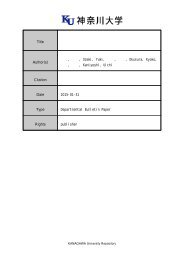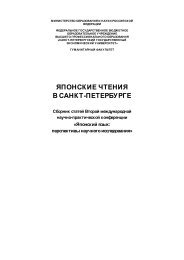to Learners with Special Educational Needs
e-textbook SEN
e-textbook SEN
You also want an ePaper? Increase the reach of your titles
YUMPU automatically turns print PDFs into web optimized ePapers that Google loves.
Pokrivčáková, S. et al. (2015). Teaching Foreign Languages <strong>to</strong> <strong>Learners</strong> <strong>with</strong> <strong>Special</strong> <strong>Educational</strong> <strong>Needs</strong>:<br />
e-textbook for foreign language teachers. Nitra: Constantine the Philosopher University. 128 p.<br />
ISBN 978-80-558-0941-0<br />
It must be mentioned that there are scholars, on the other hand, who claim that reading<br />
comics is not appropriate genre for dyslexics as text in the bubbles might be problematic (see<br />
e.g. Homolová, 2012).<br />
If you want <strong>to</strong> apply extensive reading, you may use special edition of books prepared for<br />
students <strong>with</strong> dyslexia (e.g. the special editions - quick reads, see<br />
http://www.quickreads.org.uk/resources – it is necessary <strong>to</strong> mention that these editions are for<br />
native speakers. The books are supplemented <strong>with</strong> the Learning <strong>with</strong> Quick Reads<br />
methodological support downloadable from their website. As far as we know there are no<br />
special graded readers for EFL dyslexic learners. Still, the teachers might selectively use the<br />
above mentioned readers.<br />
Similarly, the use of graphic novels allows pupils <strong>to</strong> be creative readers. Even though there is<br />
a little or no text, actually the kids read the pictures and read/create the s<strong>to</strong>ry and at the same<br />
time they develop the habit of reading and later, when they learn some compensation<br />
techniques they are motivated <strong>to</strong> overcome linguistic barriers as they have experience the joy of<br />
reading. The samples below are from Shaun Tan’s social novel The Arrival and Raymond Briggs<br />
s<strong>to</strong>ry for children Snowman.<br />
Figure 7: Sample pages from the graphic books. (Graphic novel: Shaun Tan: The Arrival – the<br />
social graphic novel about migration; Raymond Briggs: The Snowman – the book about<br />
snowman and a boy friendship; The Briggs’ book evokes the blueish feelings (he uses colours but<br />
the blue one prevails) whereas Tan works <strong>with</strong> grey and sepia shadows that evokes the feelings<br />
of old pho<strong>to</strong>graphs that create a s<strong>to</strong>ry.)<br />
Comics similarly do not provide much language, and they tell a s<strong>to</strong>ry. This is a format that can<br />
provide access <strong>to</strong> narratives for dyslexics. You may for example read Tom Sawyer and<br />
Huckleberry Finn graded reader <strong>with</strong> a group and use comics. You may delete the bubbles and<br />
students can add the text. If you want you may use software <strong>to</strong> create the comics (based on whar<br />
students read), as e.g. makebeliefscomix.com or <strong>to</strong>ondoo.com.<br />
You may also use audio books depending on your aim – but definitely this is a way how <strong>to</strong><br />
help learners <strong>with</strong> dyslexia. There are a lot of graded readers that are accompanied <strong>with</strong> the<br />
audio CD. Similarly, there are a lot of material online.<br />
54






